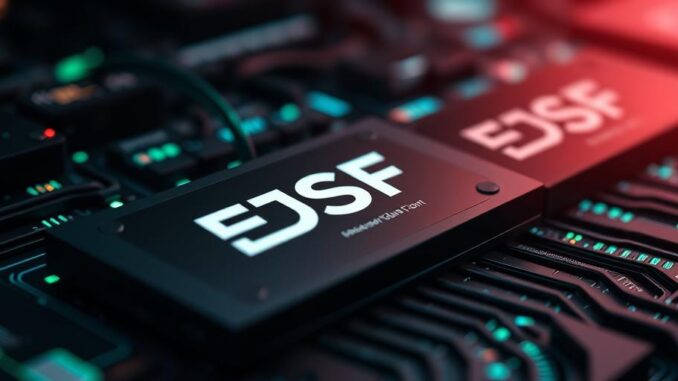
Summary
This article explores the transition from U.2 to EDSFF SSDs, highlighting the limitations of U.2 in the face of PCIe 5.0 and 6.0, and the advantages of EDSFF in terms of signal integrity, thermal management, and investment efficiency. Micron Technology advocates for the adoption of EDSFF as the future of SSD form factors, citing its superior performance and adaptability. This shift marks a significant evolution in data storage technology, paving the way for more efficient and powerful systems.
Award-winning storage solutions that deliver enterprise performance at a fraction of the cost.
** Main Story**
Okay, so, the buzz around data storage is all about moving away from U.2 to EDSFF, right? U.2’s been the go-to SSD form factor in servers for like, a decade, which is a lifetime in tech years. But with PCIe 5.0 and 6.0 hitting the scene, it’s starting to show its age. And honestly, it’s probably overdue! Micron, they’re saying it’s time to fully embrace EDSFF. Let’s dig into why.
U.2’s Got Some Issues
U.2, it’s been great. It uses that familiar 2.5-inch HDD shape and plays nice with SATA, SAS, and NVMe. It really helped SSDs become mainstream. However, in these newer, faster systems, well, it’s creaking under the strain.
-
Signal Integrity is a headache: Think of it like trying to have a clear conversation in a noisy room, only the ‘noise’ is electrical interference. With PCIe 5.0 and 6.0, the data speeds are so high that signal integrity – keeping the signal clean – becomes a huge problem. You get signal loss and noise, and the U.2 connector just wasn’t designed to isolate signals the way EDSFF connectors do. This means more crosstalk, leading to performance issues and, ultimately, less reliable data.
-
Thermal Management is struggling: Imagine a bunch of U.2 drives crammed into a server, it’s like they’re all fighting for the same bit of cool air. The density makes it hard to get rid of heat effectively, which becomes a serious problem when you’re dealing with the power-hungry PCIe 5.0 and 6.0 SSDs. You end up with throttling – the drive slowing itself down to avoid overheating – and a shorter lifespan. We don’t want that, do we?
-
Investment is lagging: Here’s the thing. The industry can’t keep pumping money into two competing technologies. EDSFF is getting all the love – new specs, SSD development, system support… U.2 is kind of left in the dust, isn’t it? And this growing gap just confirms that EDSFF is the future.
Why EDSFF is the Answer
EDSFF, or Enterprise and Data Center Standard Form Factor, it’s designed for the future. It solves a lot of the problems that U.2 is struggling with.
-
Better Signal Integrity, period: The way EDSFF’s pins are arranged isolates the sending and receiving signals. So, less crosstalk, cleaner signals, even at the crazy speeds of PCIe 5.0 and 6.0. It means data transfer is more reliable, which is critical for things like AI and high-performance computing. Remember that server crash last month? Better signal integrity could have saved us a lot of grief.
-
Cooler Temperatures are Easier: EDSFF is designed so air flows better through the server. This means heat gets whisked away more efficiently, keeping those high-power SSDs running smoothly and lasting longer. E3.S, which is one type of EDSFF, even lets you get creative with how you position the drives and route the airflow. Think of it as giving your server a nice, breezy ventilation system.
-
It’s a Smart Investment: EDSFF is looking ahead. It’s in line with where the industry is going with PCIe 5.0 and 6.0. By focusing on EDSFF, companies aren’t wasting money on outdated tech and can ensure a smooth move to these higher-performing storage solutions. It just makes sense!
The Road to EDSFF
Look, the switch to EDSFF won’t happen overnight. U.2 isn’t going anywhere tomorrow, for sure. But the momentum is building. Even Micron is offering their 9550 NVMe SSD in both U.2 and EDSFF flavors, which shows where things are headed. U.2 will probably stick around for a while, because there’s so much infrastructure already built around it. But EDSFF? It’s definitely on track to become the dominant form factor for the data centers of tomorrow.
Honestly, the industry’s reached a point where keep investing in U.2 just doesn’t make sense. EDSFF is a better bet. It offers better signal integrity, runs cooler, and can adapt to future tech. It’s the best way to keep up with the increasing storage needs of modern data centers. It’s really a big leap forward in data storage, and it’s going to lead to faster, more dependable, and more efficient systems in the long run. I think.


So, U.2 is the Blockbuster of SSDs now? Will we see vintage U.2 drives fetching a premium on eBay in 20 years? Asking for a friend who hoards obsolete tech.
That’s a fun analogy! I wonder if we’ll see U.2 drives displayed in tech museums alongside old hard drives. Perhaps some collectors will specialize in vintage data storage – imagine the conversations about interface speeds and capacity back then! Thanks for the chuckle!
Editor: StorageTech.News
Thank you to our Sponsor Esdebe
Given the advantages of EDSFF in thermal management, are there specific rack-level cooling solutions being developed to fully leverage the form factor’s airflow benefits in high-density deployments?
That’s a great question! Yes, alongside EDSFF adoption, we’re seeing innovative rack-level cooling solutions emerge. Many focus on direct liquid cooling or advanced airflow management to maximize the thermal benefits of EDSFF in dense configurations. It’s an exciting area of co-development for optimized performance.
Editor: StorageTech.News
Thank you to our Sponsor Esdebe